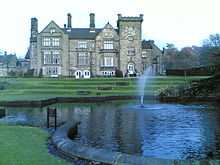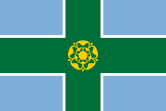Breadsall Priory
 A line drawing of Breadsall Priory, by Francis S. Darwin's daughter Violetta H. Darwin (1826–1880) | |
 Location within Derbyshire
| |
| Monastery information | |
|---|---|
| Full name | The Priory of the Holy Trinity, Breadsall |
| Other names | Breadsall Park Priory |
| Order | Augustinian Canons |
| Established | Before 1266 |
| Disestablished | 1536 |
| Dedicated to | The Holy Trinity |
| Controlled churches | Breadsall, Duffield, Horsley, Mugginton and Windley. |
| People | |
| Founder(s) | Richard, Henry or Sir Robert Curzon |
| Site | |
| Coordinates | 52°58′07″N 1°26′08″W / 52.96862°N 1.43564°W |
| Grid reference | SK380414 |
| Visible remains | A single 13th-century arch remains from the original priory buildings, within the cellars of the later building constructed on the site.[1] |

Breadsall Priory is a former priory in Derbyshire, about a mile to the north of Breadsall, and about a mile to the east of Little Eaton. The priory was established before 1266 by a member of the Curzon family. Only a very small priory, Breadsall was dissolved in 1536.
Following the Dissolution of the Monasteries the priory was demolished, and a private home, also known as Breadsall Priory, was built on the site; in the 19th and 20th centuries the house was altered and extended, and only a single arch remains of the monastic buildings. The house and its stables are both Grade II Listed. The house is currently used as a hotel, while its stables are in residential use.
History
The priory was established before the middle of the 13th century by one of three generations of the Curzon family: Richard, Henry or Sir Robert Curzon (grandfather, son and grandson).[2]
Due to a mistake made on a Patent Roll in 1266,[2] it is sometimes mistakenly claimed that it was a house of Augustinian Friars. In fact the priory was home to Augustinian Canons.[2] This is confirmed by King Henry III's grant to the priory of 20 acres of land in Horsley and Horston. Unlike Augustinian Canons, Augustinian Friars were not allowed to own land.[2]
Although the taxation roll of 1291 reveals that the priory had an annual income of £5 19s,[2] Breadsall Priory was home to only a prior and two canons, and sometimes only the prior.[2] The small number of canons meant that the prior was often chosen by a member of the Curzon family, who served as "hereditary patrons".[2] The Curzon family were Lords of the Manor of Breadsall Overhall for eight generations.[2]
During the reign of King Richard II (1377–1399), the manor passed to the Dethick family, through the marriage of Cecilia Curzon to William Dethick.[2] However, the Dethick family's relationship to the priory was, for a period, unclear.[2] In 1384, the appointment of the prior was made by Sir Thomas Wendesley, who was refereed to as Patron pro hac vice.[2] Several other priors were also appointed by the Bishop of Lichfield, rather than the Dethick family.[2] However, in 1456 the bishop confirmed Sir William Dethick's right to "the first licence to elect or provide a superior when the priory was vacant".[2]
In 1402 William Dethick, son of Cecilia Curzon, donated a moiety of the rectory of Mugginton to Breadsall. Dethick however had failed to follow proper procedure to alienate the lands; upon his death therefore his "executors and trustees" were "heavily fined" by the crown.[2]
In 1444, the priory was sued by the Collegiate Church of St Mary in Leicester, over the tithes of a field called Hethfield, near Mugginton.[2] St Mary's argued that Hethfield belonged to the Parish of Duffield (which was in their control), and not that of Mugginton (which was controlled by the priory).[2] The court found in favour of St Mary's and control of the field passed from the priory to the collegiate church.[2] The rector of Mugginton was "condemned for contempt of Court of Arches" and ordered to pay the 40s. to St Mary's.[2]
In 1448, Prior Thomas Breadsall complained to the bishop that "certain charters and evidences" had been stolen from the priory.[2] The bishop ordered that at high mass in several local churches priests should spread the news of the theft, and instruct that the perpetrators were to be excommunicated unless the items were not returned within 15 days.[2] It is not known whether this strategy worked.[2]
In 1453, John Statham of Morley donated money for the repair of the priory church roof, and glazing in its clerestory.[2] In return, Prior Thomas Breadsall agreed that the priory would celebrate mass annually, on the feast of the Eleven Thousand Virgins, for the souls of Goditha, Thomas, Elizabeth Cecilia and John Statham.[2]
In 1454, a canon at Breadsall, John Derby (who was "probably a gifted preacher"[2]), was granted a licence from Reginald Boulers, Bishop of Coventry and Lichfield to travel around the diocese preaching in its parish churches.[2]
The Valor Ecclesiasticus of 1535 records Breadsall Priory had an annual income, after expenses, of £10 17s. 9d., and was in control of the parishes of Breadsall, Duffield, Horsley, Mugginton and Windley.[2] The prior, William Pendylton, was the only resident at the priory at the time.[2]
The priory was dissolved in 1536.[2] Pendylton, was awarded a "minute pension" of only 5 marks a year.[2]
Of the original priory buildings, only a single 13th-century arch remains, in the cellars of the later building constructed on the site.[1]
Priors
A list of the known priors of Breadsall.[2]
- Hugh de Mackworth. Appointed in 1306: "under the patronage of Richard Curzon".
- Hamund de Merston. Appointed in 1309. Also chosen by Richard Curzon.
- Reappointed in 1322. This time chosen by Henry Curzon.
- William de Repyndon. Formerly a canon at Breadsall. Resigned as Prior in October 1347.
- Thomas de Castello. Appointed 1347 on the advice of the Abbot of Darley Abbey.
- Thomas de London. Appointed in 1365 after the position of Prior had been vacant for several years. Previously a monk at Burton Abbey.
- Geoffrey de Stafford. Resigned 1370.
- Thomas Lewes. Appointed 1370.
- Roger Upton. Appointed 1384 by Sir Thomas Wendesley.
- Thomas Holand (also known as Thoams Bakster). Served 1431–1442.
- Thomas Beadsall. Served 1442–1456.
- Robert Burton. Served October 1456–1487. Formerly a canon at Repton Priory. Appointed by Sir William Dethick.
- Henry Halom. Appointed 1487.
- John Alton. Died in office, 1519.
- Thomas Beyston. Appointed 1519.
- William Pendyltion. The priory was dissolved in 1535.
History after dissolution
During the Dissolution of the Monasteries some of the priory's land was transferred to Darley Abbey; when this too was dissolved, the land passed to the crown.[2] The site was granted by the Crown to the Duke of Suffolk,[citation needed] and by September 1536, the priory site was tenanted and farmed by Lawrence Holland of Belper.[2]
Breadsall subsequently has passed through numerous owners. In the late 16th-century, when under the ownership of Sir John Bentley, an Elizabethan "E-plan" house was constructed on the former priory site.[citation needed] The original house, also known as Breadsall Priory, was altered and extended by architect Robert Scrivener around 1861, and a new wing was added in 1906.[3] The house's stable buildings were constructed in the mid-19th-century.[4]
The physician and poet Erasmus Darwin, grandfather of Charles Darwin, moved there shortly before his death in 1802, and he was followed by his son Sir Francis Sacheverel Darwin (1786–1859), and his son Edward Levett Darwin, author (under the pseudonym High Elms) of the Gameskeeper's Manual, who learnt about natural history in its grounds.
Later, Derby industrialist Sir Alfred Seale Haslam (1844–1927), (Mayor of Derby 1890/91,[5] Member of Parliament for Newcastle under Lyme 1900/6) acquired the house. His son Eric Seale Haslam was High Sheriff of Derbyshire in 1937.
The building is currently a Marriott hotel with two 18-hole golf courses, one set in mature parkland called the Priory Course, and the other called the Moorland Course.[6] In 2005, the priory hosted a G8 summit meeting of environment and development ministers.[7]
The house was Grade II Listed on 2 September 1952.[3] The associated stables, built in the mid-19th-century, are in residential use. The stables were Grade II Listed on 6 November 1986.[4]
References
- ↑ 1.0 1.1 English Heritage. "BREADSALL PRIORY". PASTSCAPE. Retrieved 27 May 2013.
- ↑ 2.0 2.1 2.2 2.3 2.4 2.5 2.6 2.7 2.8 2.9 2.10 2.11 2.12 2.13 2.14 2.15 2.16 2.17 2.18 2.19 2.20 2.21 2.22 2.23 2.24 2.25 2.26 2.27 2.28 2.29 2.30 2.31 William Page (ed.) (1907). 'Houses of Austin canons: The priory of Breadsall', A History of the County of Derby: Volume 2. pp. 54–56.
- ↑ 3.0 3.1 "Breadsall Priory, Breadsall". British Listed Buildings. Retrieved 29 January 2014.
- ↑ 4.0 4.1 "Stable Block North West of Breadsall Priory, Breadsall". British Listed Buildings. Retrieved 29 January 2014.
- ↑ ‘HASLAM, Sir Alfred Seale’, Who Was Who, A & C Black, 1920–2007; online edn, Oxford University Press, December 2007 [http://www.ukwhoswho.com/view/article/oupww/whowaswho/U197630, accessed 19 July 2008]
- ↑ Hotel website
- ↑ BBC News 16 Mar 2005
Sources
- English Heritage: Images of England, photograph and architectural description of listed building
- History and Gazetteer of the County of Derby Pt 1 Vol 2 (1829) Stephen Glover p 152 (Google Books): Breadsall Priory
- Haslam Papers at National Archives (Derbyshire Record Office) ref GB/0026/D1333
External links
| Wikimedia Commons has media related to Breadsall Priory. |
| ||||||||||||||||||||||
